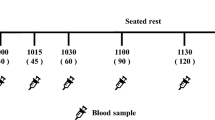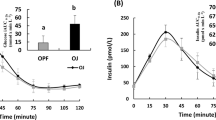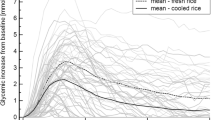Abstract
This pilot study investigated the effects of chilling and reheating a pasta-based meal on the postprandial glycaemic response. In this single-blind crossover study, 10 healthy volunteers consumed identical pasta meals (pasta, olive oil, and tomato sauce), served either freshly prepared, chilled, or chilled/reheated, on three separate randomised occasions. Capillary blood samples were taken for two hours postprandially. A significant difference in glucose Incremental Area Under the Curve was observed (p = 0.006), with the greatest difference observed between the freshly cooked and chilled/reheated meals (p = 0.041). Significant differences in incremental peak glucose were also observed (p = 0.018). These results suggest that making simple changes to domestic food processing methods can reduce the glycaemic excursion following a pasta meal, with the potential for health benefit.
This is a preview of subscription content, access via your institution
Access options
Subscribe to this journal
Receive 12 print issues and online access
$259.00 per year
only $21.58 per issue
Buy this article
- Purchase on Springer Link
- Instant access to full article PDF
Prices may be subject to local taxes which are calculated during checkout

Similar content being viewed by others
References
International Diabetes Federation. IDF Diabetes Atlas, 9th ed. [Internet]. 2019 [cited 2020 May 15]. https://www.diabetesatlas.org/en/.
Ruijgrok C, Blaak EE, Egli L, Dussort P, Vinoy S, Rauh SP, et al. Reducing postprandial glucose in dietary intervention studies and the magnitude of the effect on diabetes-related risk factors: a systematic review and meta-analysis. Eur J Nutr. 2020;1–15. https://link.springer.com/article/10.1007/s00394-020-02240-1#citeas.
Leeman M, Östman E, Björck I. Vinegar dressing and cold storage of potatoes lowers postprandial glycaemic and insulinaemic responses in healthy subjects. Eur J Clin Nutr. 2005;59:1266–71.
Chao C, Yu J, Wang S, Copeland L, Wang S. Mechanisms underlying the formation of complexes between maize starch and lipids. J Agric Food Chem. 2018;66:272–8.
Reed MO, Ai Y, Leutcher JL, Jane J. Effects of cooking methods and starch structures on starch hydrolysis rates of rice. J Food Sci. 2013;78:H1076–81.
BBC Two - Trust Me, I’m a Doctor, Series 2, Episode 1 - Can my leftovers be healthier than the original meal? [Internet]. [cited 2020 May 29]. https://www.bbc.co.uk/programmes/articles/3LncBcDcCXKgtpFvrDZVnNQ/can-my-leftovers-be-healthier-than-the-original-meal.
Brouns F, Bjorck I, Frayn KN, Gibbs AL, Lang V, Slama G, et al. Glycaemic index methodology. Nutr Res Rev. 2005;18:145–71.
Lu L, Monro J, Lu J, Rush E. Effect of cold storage, reheating, and particle sizes on in vitro glucose release and starch digestibility among five rice products in Auckland, New Zealandu, LW. Rice Res Open Access. 2016;4:1000171.
Ai Y, Hasjim J, Jane J. Effects of lipids on enzymatic hydrolysis and physical properties of starch. Carbohydr Polym. 2013;92:120–7.
Lukić I, da Ros A, Guella G, Camin F, Masuero D, Mulinacci N, et al. Lipid profiling and stable isotopic data analysis for differentiation of extra virgin olive oils based on their origin. Molecules. 2019;25:4.
Hodges C, Archer F, Chowdhury M, Evans BL, Ghelani DJ, Mortoglou M, et al. Method of food preparation influences blood glucose response to a high-carbohydrate meal: a randomised cross-over trial. Foods. 2020;9:23. https://www.ncbi.nlm.nih.gov/pmc/articles/PMC7022949/.
Sonia S, Witjaksono F, Ridwan R. Effect of cooling of cooked white rice on resistant starch content and glycemic response. Asia Pac J Clin Nutr. 2015;24:620–5.
Acknowledgements
Thanks to Dr Francesca P. Robertson (University of Surrey) for assisting with the laboratory analysis of the blood samples.
Funding
This work was part-funded by the British Broadcasting Corporation (BBC) and sponsored by the University of Surrey.
Author information
Authors and Affiliations
Contributions
TMR and MDR designed the study and conducted the research. TMR analysed the data. All authors contributed to interpretation of results and writing the report.
Corresponding author
Ethics declarations
Conflict of interest
The authors declare that they have no conflict of interest.
Additional information
Publisher’s note Springer Nature remains neutral with regard to jurisdictional claims in published maps and institutional affiliations.
Rights and permissions
About this article
Cite this article
Robertson, T.M., Brown, J.E., Fielding, B.A. et al. The cumulative effects of chilling and reheating a carbohydrate-based pasta meal on the postprandial glycaemic response: a pilot study. Eur J Clin Nutr 75, 570–572 (2021). https://doi.org/10.1038/s41430-020-00736-x
Received:
Revised:
Accepted:
Published:
Issue Date:
DOI: https://doi.org/10.1038/s41430-020-00736-x



